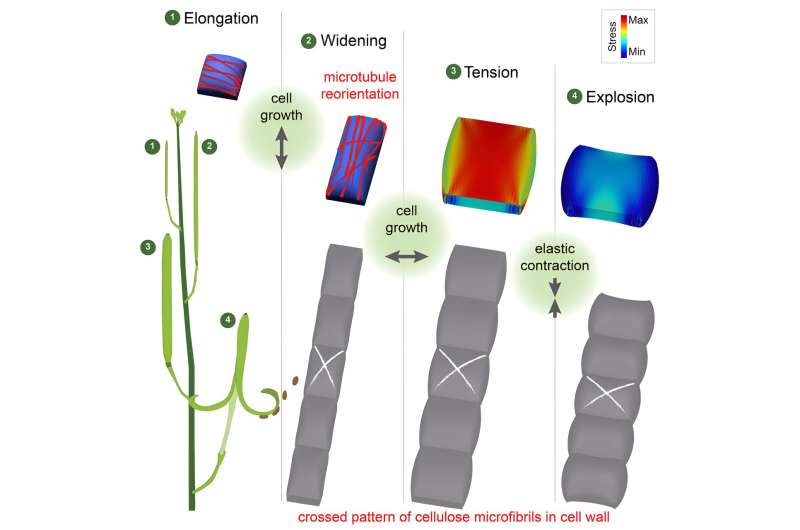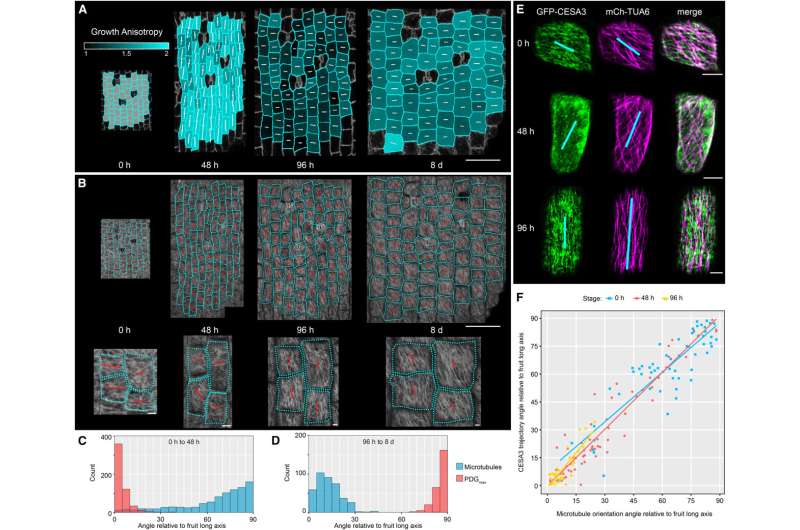This article has been reviewed according to Science X's editorial process and policies. Editors have highlighted the following attributes while ensuring the content's credibility:
fact-checked
peer-reviewed publication
trusted source
proofread
How a wayside weed builds up explosive force to hurl seeds

Hairy bittercress is one of those plants that hurl their seeds in all directions to spread them effectively. A research team has now discovered that to do this, the plant uses a previously unknown mechanism that makes the seed pods contract and snap open, acting almost like a muscle.
Dr. Gabriella Mosca at the University of Tübingen's Center for Plant Molecular Biology was one of the lead authors in this study headed by Dr. Angela Hay from the Max Planck Institute for Plant Breeding Research in Cologne. The results have now been published in Current Biology.
Hairy bittercress (Cardamine hirsuta) is a herbaceous annual plant that grows up to 30 centimeters tall. "These pods consist of two long valves. When the seeds are ready for dispersal, these valves rapidly coil back, accelerating seeds at astonishing speeds—up to 10 meters per second," Angela Hay reports.

Pressure buildup
The study's lead authors, Dr. Gabriella Mosca and Dr. Ryan Eng, discovered that the plant exploits the growth process of its own cells to produce tissue-wide contraction in the pods, building up enough tension to make them explode. "It seems contradictory that expansive growth should lead to tissue contraction, but under certain conditions one can lead to the other," says Mosca.
During growth, cells in the pods change not only in size, but also shape. The shape of each cell is influenced by the arrangement of cellulose fibers in its walls. "These fibers are like steel cables that can hardly be stretched. So, the growing cell has no choice but to grow at right angles to the cellulose fibers," explains Mosca.
"In explosive seed pods, the cellulose fibers are arranged in such a way that the cells grow into a specific shape which, under the action of turgor pressure inside each cell, causes tissue-wide contraction. This acts almost like a muscle contracting in a human or animal."
Computer model of the cell wall
The process is optimized by the crisscross pattern of cellulose fibers in the cell wall. "When the cells grow with crossed cellulose fibers instead of parallel ones, this adds an extra stretch," Mosca says. "The crisscrossing cellulose fibers in the seed pods' cell walls may appear random. But in fact, the pattern is essential to the ejection mechanism."
The researchers used live cell imaging and quantitative techniques to measure cellular growth. In addition, Mosca, in collaboration with Dr. Richard Smith from the John Innes Center, developed a computer model of the multi-layered structure of plant cell walls for this study. This model is part of a software they developed to model plant mechanics and growth, named MorphoMechanX. The model may now be used in further studies on the biomechanics of plants and in cell wall research.
For the researchers Angela Hay and Gabriella Mosca, the results also raise further questions. "We want to understand how microtubules reorient in a coordinated switch during pod growth. The explosive process hinges on this switch," says Hay. Microtubules are structural helpers in the cell that form a kind of rail system to guide the construction of cellulose fibers.
"Furthermore, by filming the ejection process, we noted that all the pod valves roll up in the same spatial arrangement during the explosion. In my working group at the University of Tübingen, I would like to continue investigating the mechanism by which this is coordinated," says Mosca.
More information: Gabriella Mosca et al, Growth and tension in explosive fruit, Current Biology (2024). DOI: 10.1016/j.cub.2024.01.059
Journal information: Current Biology
Provided by Universitaet Tübingen




















